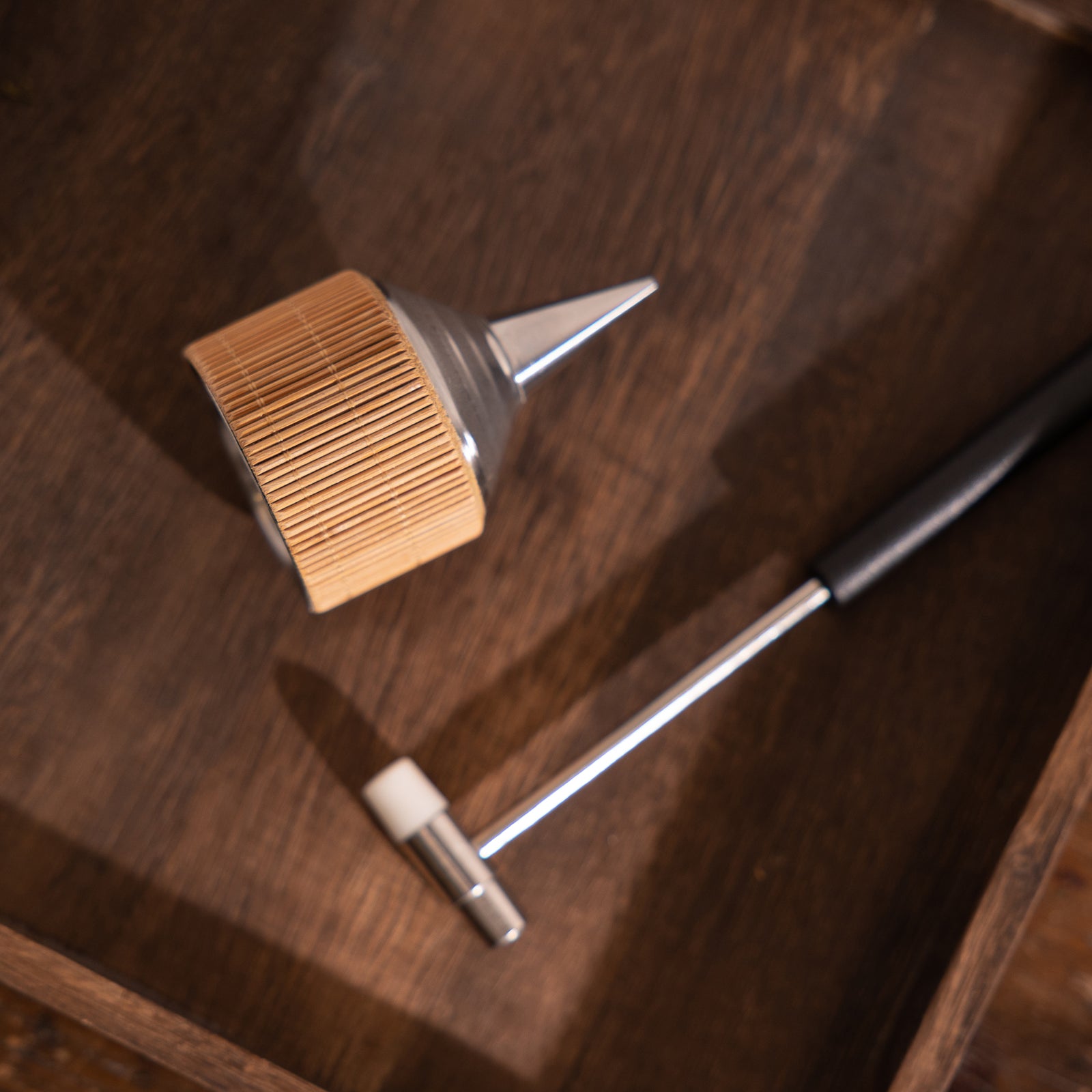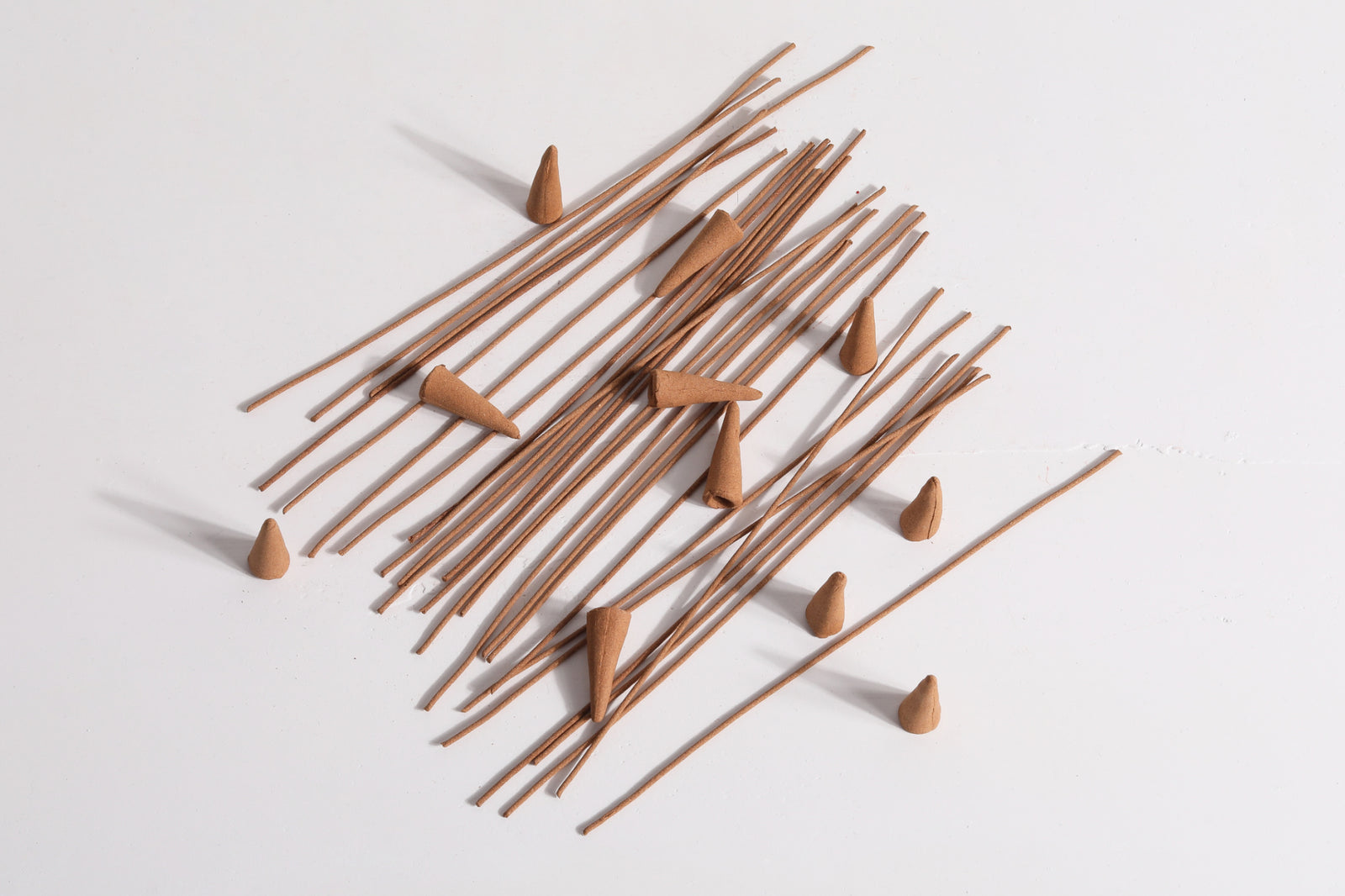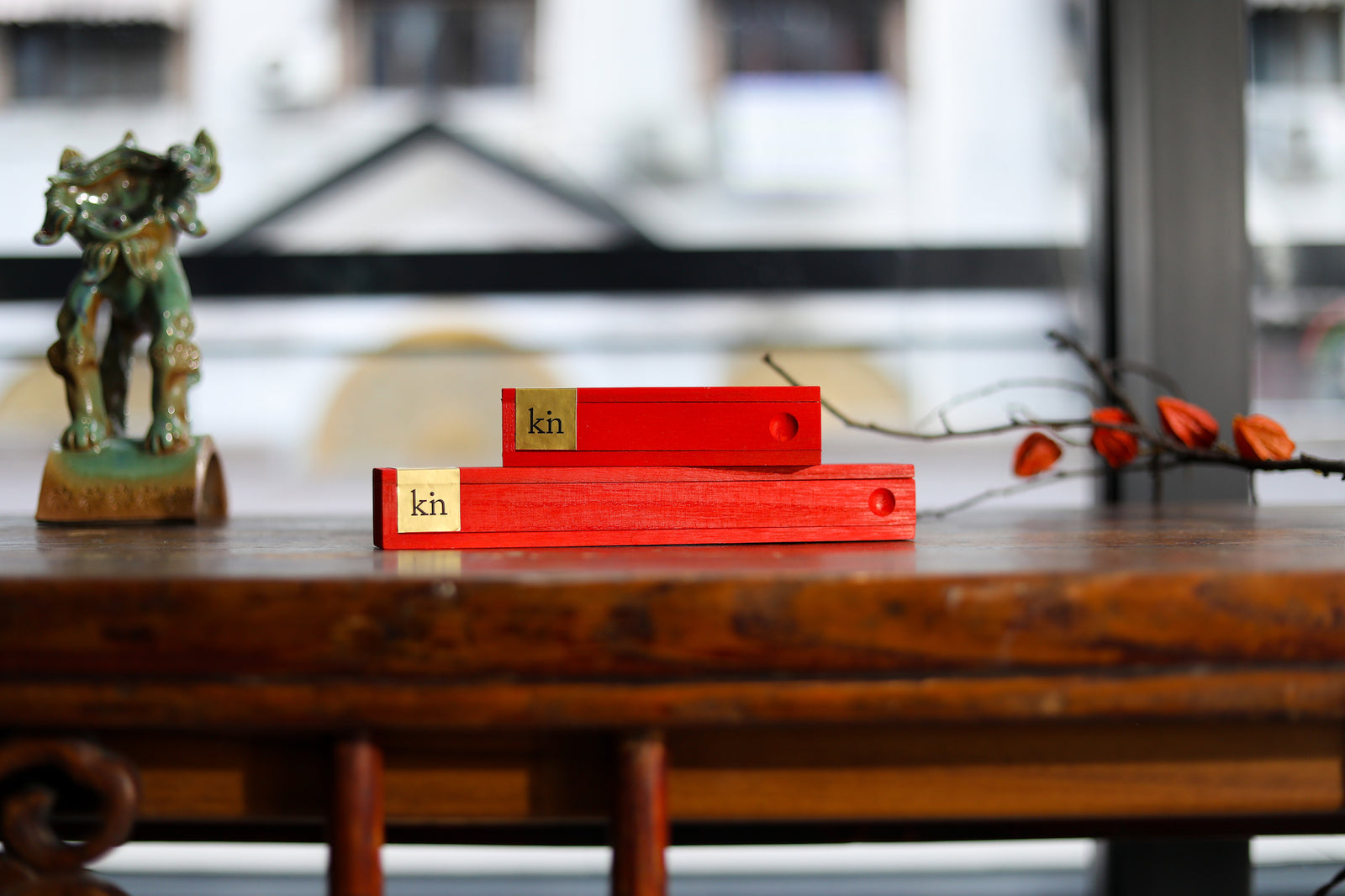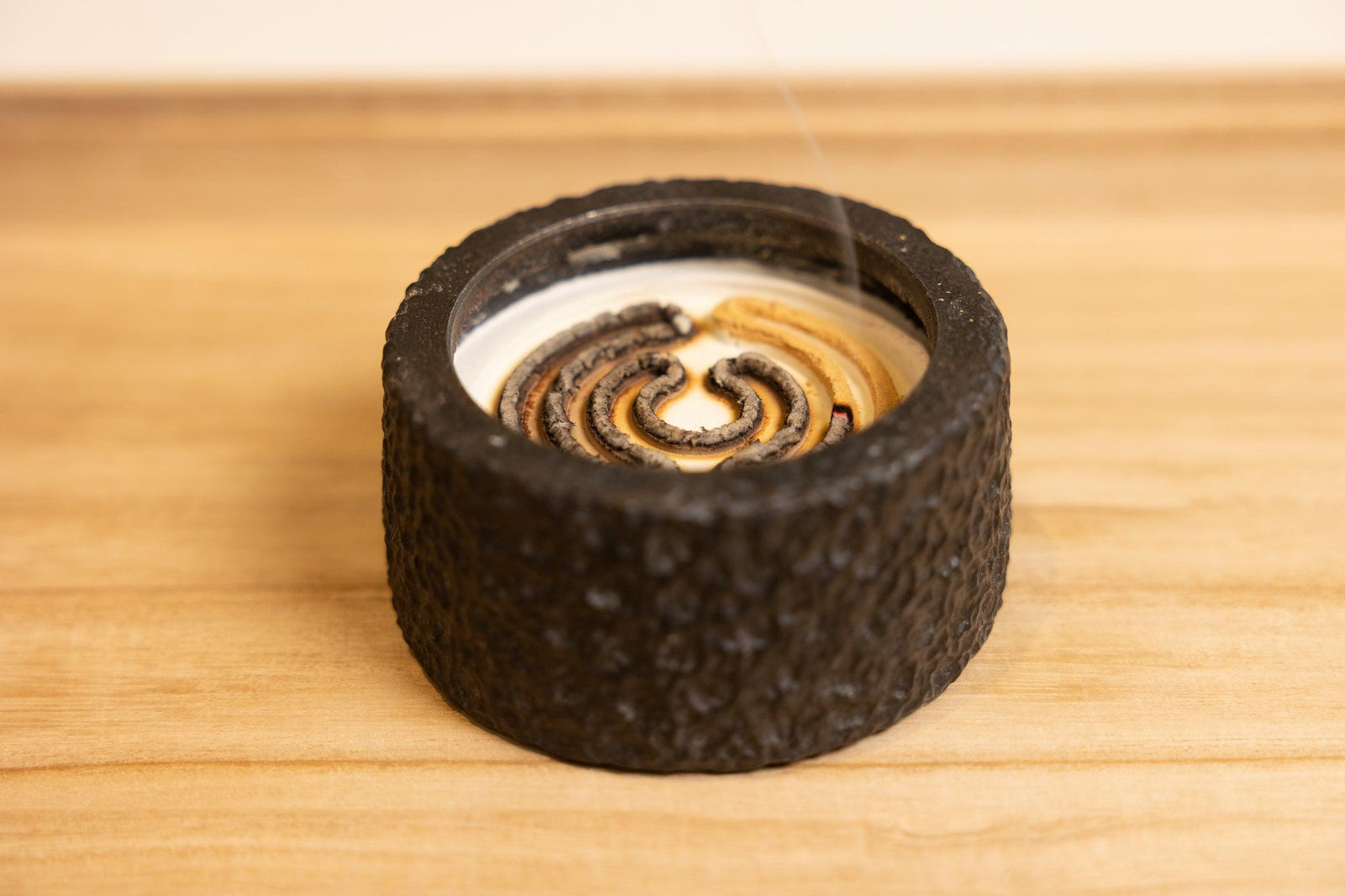Incense has a long history and there are many different types of incense. Today, stick and cone shaped incense are the two most commonly used forms, and we hand blend and hand make both both types in our studio, so they are the types that we know best. This article will focus on a detailed comparison of the two.
(A note before we get started, we also have several very detailed articles on how we hand make our incense cones, and how we hand make our incense sticks. Some of the information is summarized below, but if you are interested in more details, please refer to those.)
How Incense Sticks Are Made
The earliest stick shaped incense appeared in China in the Ming Dynasty (1348-1644), and it has since become the most popular form of incense in use. You might hear incense sticks being referred to as “joss sticks” from time to time, although we try to refrain from using this phrase as we find it has become mostly associated with cheaper, lower quality sticks.
There are two types of incense sticks: one type with a center, and one without.

The type with a center is seen as more Indian in its origin and associations. The popular Nag Champa incense is almost always made with a bamboo center. This type of stick incense is made by dipping a thin, bare bamboo stick into waters, essential oils and incense powders in layers. The final incense stick is mostly covered with thick layers of the mixture, except for the bottom, where the bamboo stick is bare, and where you hold the incense stick or use that section to stick into a holder.

The type without a center is the one more commonly used in China, and almost exclusively through Japan and Tibet. If it helps with visualization: it is made a bit like pasta. First an incense paste is rolled, which is made from a mixture of powdered dried incense ingredients, a binding agent and some water. The binding agent is often a type of wood powder called Nanmu in Chinese, or Makko in Japanese. Then the incense paste is formed into a stick shape, and allowed to dry.
The actual blend of incense powder in each type of incense sticks is carefully selected to create a particular final scent, in a similar way essential oils or perfume ingredients are blended in specific formulas.
How Incense Cones Are Made

Typical incense cones are made in a very similar way to incense without a core. Continuing on with the metaphor above, you could think of it as being a different shape of “pasta” if you’d like. Instead of forming the paste into the long, thin stick shape, incense paste is placed into cone shaped molds, removed, then allowed to dry.

There is a specific type of incense cone called backflow incense cone, which is quite popular in our store. Backflow incense cones are unique in that their incense smoke flows downwards instead of upwards. These cones have a small hollow tunnel through 3/4 of the center of the cone, ending with a hole at the bottom.(This provides more details on how backflow incense works).
Are the Ingredients for Incense Sticks and Cones Different?
As you can see from the descriptions above, the types of ingredients used are fairly similar between stick incense and cone incense. In a way, they are like pasta of different shapes. We go through the sample structure for an incense stick recipe in this article, and the sample structure for an incense cone in this article- you can check these out for more details if you're interested, but the main difference between the two is simply the percentage of binder used.
One thing to point out though is that the most expensive incense tend to be made in stick form, without a core. This is for a few reasons. First, because an incense stick burns more slowly and evenly, it gets through the ingredients more slowly, and if the ingredients are particularly expensive, it allows one to savor them for longer. Secondly, incense sticks are easier to form and dry - incense cones need to be of particular types of textures in order form well in the mold and dry in the cone shape, incense sticks are more forgiving, and therefore allow a greater variety and combination of blends.
Lastly, the most expensive incense do not have a core. Bamboo cores have a scent which some people find unpleasant, so sometimes expensive cored incense sticks are made with a sandalwood core. But even the sandalwood distorts the smell of the incense paste blend, so for those who want to truly experience the smell of particular blends or materials other than sandalwood, the preference is to have no core.
Are the steps to lighting stick incense and cone incense different?
Both incense sticks and cones are lit in a similar way, ie, by light the tip of the incense, then fanning out the flame, leaving a glowing ember. However, new users will find incense sticks somewhat easier to light as the tip catches the flame more easily. (We also have step-by-step instructions on lighting incense sticks and lighting backflow incense cones)
How long does it take an incense stick to burn? And how long does it take an incense cone to burn?

Even though Incense cones may look bigger than incense sticks, they actually burn faster.
A full length Chinese incense stickmeasuring 21cm/8.25” long and 1.5-2mm/ 1/16” in thickness will burn in 40-70 minutes, depending on the ingredients used. Sticks in the Kin Premium Collection are some of the longest burning incense we've used, and the full length sticks burn for 60-70 minutes.
Shorter Japanese style incense sticks (10-15cm/4-5.5” long and somewhat thicker) generally burn for 20 to 35 minutes. Note both these types of incense do not have a core. Incense with a core can be longer than incense without a core, and many are about 27cm/10.75 long. This length of cored incense can burn for about 60 minutes.
Incense cones burn faster because they are much thicker than incense sticks, so at anytime the amount of surface being burnt is much more than an incense stick. Our backflow incense cones range in burn time, from 10-25 minutes. However the mesmerizing effect of backflow incense is dependent on this more rapid burn time, which leads to the steady release of the larger quantity of smoke
Unlike incense sticks, there is not as much standardisation in the size of incense cones. Non-backflow incense cones will burn for 15-30 minutes depending on their size.
Do incense sticks and incense cones smell different?
Incense sticks tend to have a lighter smell than incense cones, and the smell is more even throughout the burn time. This is because the amount of surface being burnt is constant and does not change as the stick is burnt.
In comparison, the smell of incense cones is more intense, and increases over the length of the cone. This is because the amount of surface being burnt moves from the small, pointy tip to the wider body.
How to clean up burnt incense sticks and incense cones?
Some customers find incense sticks somewhat difficult to clean up, because as it burns, little pieces of ash falls off. If the incense holder itself does not have an area to collect this ash, it may be difficult to keep the surface around the incense to clean.
We ourselves clean up after burning incense sticks in two ways. If we are using an incense holder with an area that collects incense ash (many of our stick incense holders have this function), we wait for the burnt incense and holder to cool down (about 5min), then hold the burner over a trash can and tip the ash in. If we are using an incense holder that does not collect ash, we will lay a piece of silicone mat (or other non-flammable material) under the incense holder, and after the incense has finished burning, remove the burner, pick up the mat, and similarly hold it over the trash can to tip all of the ash in.
Cone incense in comparison is fairly easy to clean. As it burns, the ash stays in place in the cone shape. Once burnt through, simply wait for the burnt incense and incense holder to cool down, pick up the plate the incense cone is sitting on, and drop the cone-shaped ash into the trash.
One thing to remember is this: it’s easiest to not touch or handle the ash, as that makes it lose its shape and crumble, which is even more difficult to clean up.
So are incense sticks or cones better?

If you want a soft, even smell to accompany meditation, yoga, or just some work and reading, and you want the smell to last for half an hour or longer, and do not need the smell to be released quickly, then incense sticks would be a good choice.

If you want to give your home a quick boost of scent, standard incense cones would be great. Light then up about 5min before guests arrive, and they will be greeted with the scent as they walk through the door.

Backflow incense cones are best used when you are in the mood for something more visual. The design of backflow incense burners have far more variety than traditional incense burners, and the interplay of backflow incense smoke with the burners can be quite stunning. If you have a few friends gathered around the coffee table chatting, it would be a good time to light up a backflow incense, and together enjoy the flow of incense smoke in its mesmerizing ways. Sometimes I also light up a backflow incense when I want to watch something calming, it’s a different type of meditation I suppose.
So as you can see, the choice of incense sticks or cones really depends on the occasion. Like many things in life, there is no better or worse, just whether it suits your needs at that point in time. We use all types of incense depending on our mood, and we enjoy them all.
For more history, background and details of other types of incense, please check out this article.






Leave a comment (all fields required)